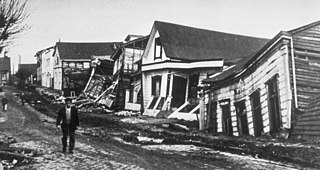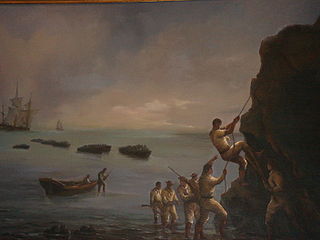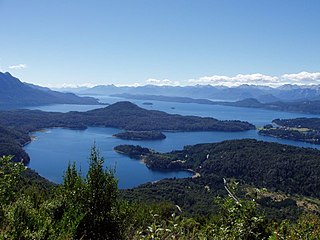Related Research Articles

The black-necked swan is a species of waterfowl in tribe Cygnini of subfamily Anserinae. It is found in Argentina, Brazil, Chile, Uruguay, and the Falkland Islands.

The 1960 Valdivia earthquake and tsunami or the Great Chilean earthquake on 22 May 1960 was the most powerful earthquake ever recorded. Various studies have placed it at 9.4–9.6 on the moment magnitude scale. It occurred in the afternoon, and lasted for approximately 10 minutes. The resulting tsunamis affected southern Chile, Hawaii, Japan, the Philippines, eastern New Zealand, southeast Australia, and the Aleutian Islands.

Valdivia is a city and commune in southern Chile, administered by the Municipality of Valdivia. The city is named after its founder, Pedro de Valdivia, and is located at the confluence of the Calle-Calle, Valdivia, and Cau-Cau Rivers, approximately 15 km (9 mi) east of the coastal towns of Corral and Niebla. Since October 2007, Valdivia has been the capital of Los Ríos Region and is also the capital of Valdivia Province. The national census of 2017 recorded the commune of Valdivia as having 166,080 inhabitants (Valdivianos), of whom 150,048 were living in the city. The main economic activities of Valdivia include tourism, wood pulp manufacturing, forestry, metallurgy, and beer production. The city is also the home of the Austral University of Chile, founded in 1954 and the Centro de Estudios Científicos.

The protected areas of Chile are areas that have natural beauty or significant historical value protected by the government of Chile. These protected areas cover over 140,000 km2 (54,054 sq mi), which is 19% of the territory of Chile. The National System of Protected Wild Areas is regulated by law #18,362 passed in 1984, and administered by the National Forest Corporation (CONAF).

The Cruces River is a river in south-central Chile. Río Cruces originates from hills near the Villarica volcano and flows then in south-west direction. The southern and final part of the river flows in a south-south-west direction following the eastern flank of Cordillera de Oncol. At the latitude of the city of Valdivia it is crossed by Río Cruces Bridge next to its outflow into Valdivia River.

The Capture of Valdivia was a battle in the Chilean War of Independence between Royalist forces commanded by Colonel Manuel Montoya and Fausto del Hoyo and the Patriot forces under the command of Thomas Cochrane and Jorge Beauchef, held on 3 and 4 February 1820. The battle was fought over the control of the city Valdivia and its strategic and heavily fortified harbour. In the battle Patriots gained control of the southwestern part of the Valdivian Fort System after an audacious assault aided by deception and the darkness of the night. The following day the demoralised Spanish evacuated the remaining forts, looted local Patriot property in Valdivia and withdrew to Osorno and Chiloé. Thereafter, Patriot mobs looted the property of local Royalists until the Patriot army arrived to the city restoring order.

Mariquina is a commune in southern Chile, Valdivia Province, Los Ríos Region. It is located about 40 km northeast of Valdivia, close to Cruces River. The capital is the city of San José de la Mariquina. The commune's main economic activities are agriculture, cattle farming and wood pulp manufacturing.
Oncol Park is a natural reserve located 32 km (20 mi) from the city of Valdivia, Chile. The park has an area of 7.54 km2 (3 sq mi) of which most lies on Cerro Oncol, the highest peak of the Valdivian Coast Range, but is only 5 km (3 mi) from the coast. Oncol Park is located in an area of 15 km2 (6 sq mi) of continuous Valdivian temperate rain forest. From the peak of Cerro Oncol it is possible to see Llaima Volcano, Villarrica Volcano and even Mount Tronador on the international border of Chile and Argentina. The park is property of the wood pulp enterprise Celulosa Arauco y Constitución.
Carlos Anwandter Nature Sanctuary is protected wetland in Cruces River about 15 km (9 mi) north of Valdivia, Chile. The sanctuary is named after the German politician Carlos Anwandter who settled in Valdivia in 1850. This sanctuary provides a home for many native waterbird species to flourish, and contains roughly 119 species of birds alone. The most numerous bird species in the sanctuary are the black-necked swans followed by coots.

The Chono, or Guaiteco were a nomadic indigenous people or group of peoples of the archipelagos of Chiloé, Guaitecas and Chonos.
Celulosa Arauco y Constitución is a Chilean wood pulp, engineered wood and forestry company controlled by Anacleto Angelini's economic group; Empresas Copec. In 2006 CELCO/ARAUCO had five pulp mills in Chile and one in Argentina. Apart from pulp mills, CELCO/ARAUCO has 4 engineered wood manufacturing plants in Chile, 2 in Argentina and 2 in Brazil.
Valdivia is one of the few cities in southern Chile with a more less continuous and well documented history from its foundation in the 16th century onwards.
The Valdivia Pulp Mill or Planta Valdivia is a pulp mill and biomass-fueled electrical generating station in San José de la Mariquina, Los Ríos Region, Chile. Although the main activity is wood pulp production, it also generates 61 MW of electricity from the burning of volatiles and black liquor. The plant was built in 2004 and is owned by Celulosa Arauco y Constitución also called CELCO.

Limnobium laevigatum is a floating aquatic plant, and is a member of the family Hydrocharitaceae. Common names include West Indian spongeplant, South American spongeplant and Amazon or smooth frogbit. This plant was introduced to North American waterways through use in aquariums and aquascapes.
From 1850 to 1875, some 30,000 German immigrants settled in the region around Valdivia, Osorno and Llanquihue in Southern Chile as part of a state-led colonization scheme. Some of these immigrants had left Europe in the aftermath of the German revolutions of 1848–49. They brought skills and assets as artisans, farmers and merchants to Chile, contributing to the nascent country's economic and industrial development.

The Dutch expedition to Valdivia was a naval expedition, commanded by Hendrik Brouwer, sent by the Dutch Republic in 1643 to establish a base of operations and a trading post on the southern coast of Chile. With Spain and the Dutch Republic at war, the Dutch wished to take over the ruins of the abandoned Spanish city of Valdivia. The expedition sacked the Spanish settlements of Carelmapu and Castro in the Chiloé Archipelago before sailing to Valdivia, having the initial support of the local natives. The Dutch arrived in Valdivia on 24 August 1643 and named the colony Brouwershaven after Brouwer, who had died several weeks earlier. The short-lived colony was abandoned on 28 October 1643. Nevertheless, the occupation caused great alarm among Spanish authorities. The Spanish resettled Valdivia and began the construction of an extensive network of fortifications in 1645 to prevent a similar intrusion. Although contemporaries considered the possibility of a new incursion, the expedition was the last one undertaken by the Dutch on the west coast of the Americas.

The Mission of Nahuel Huapi was an intermittent Jesuit mission that existed in colonial times on the shores of Nahuel Huapi Lake, northern Patagonia. The exact locations of the missions are not known but it has been suggested, based on a Christian grave finding, that the mission of the early 18th century was located in Huemul Peninsula.
Mariana Matthews is a Chilean photographer, curator, and visual artist whose technique is mainly based on the use of documentary photography, contemporary art, and experimental art.
The Huilliche uprising of 1792 was an indigenous uprising against the Spanish penetration into Futahuillimapu, territory in southern Chile that had been de facto free of Spanish rule since 1602. The first part of the conflict was a series of Huilliche attacks on Spanish settlers and the mission in the frontier next to Bueno River. Following this a militia in charge of Tomás de Figueroa departed from Valdivia ravaging Huilliche territory in a quest to subdue anti-Spanish elements in Futahuillimapu.
References
- ↑ Quinchamalí, Provincia de Ñuble, Chile"
- ↑ Zenit (camera)
- ↑ "OAS - Americas Magazine"
- ↑ "Ricardo Carrasco Stuparich National Geographic Profile"
- ↑ "Court findsCelco guilty of polluting Cruces River". Tasmanian Times . July 27, 2009. Retrieved May 14, 2019.
- ↑ "Chilean Pulp Mill Poisons Swans in Their Sanctuary" November 21, 2005.
- ↑ "Reportaje de Ricardo Carrasco Stuparich sobre el Valle del Colca, Perú"
- ↑ "Embajada de Chile en China" Retrieved May 14, 2019.
- ↑ "Caption Magazine". Caption Magazine.